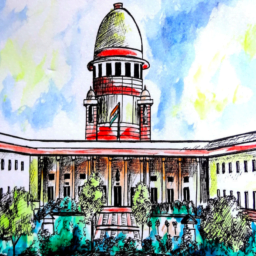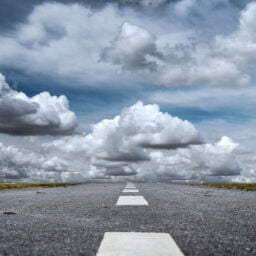INTRODUCTION
In 2019, the Government of India announced the central Vista redevelopment project. That is the stretch between the Rashtrapati Bhavan and the India Gate in New Delhi. Rashtrapati Bhavan, North Block, South Block, Vice-President House all are included in it. It is a 3- km- long stretch between the Rashtrapati Bhavan and the India Gate. The government wants to redevelop this entire area[1]. The blueprint of the project being developed. A new Parliament building is one of the main features of the central Vista redevelopment project but this is not the sole feature. The central Vista project also included the plans for a new Central Secretariat, a new PM’s residence and office, and a new Vice-president house as well as a large park. The cost of 971 crores mentioned is only that of the new Parliament building. In total the cost of this central Vista project is estimated to be around 20,000 crore rupees while laying the foundation stone for the new Parliament building, PM Modi said it will become “a symbol of a new and self-reliant India” i.e. of “ Atmanirbhar Bharat”[2].
NEW PARLIAMENT FEATURE
The new Parliament will be constructed adjacent to the existing Parliament building. It will be triangular and of a four-storeyed building. Several people have compared its shape with that of the Pentagon- the building in the USA. Its interior will have three national symbols- the Lotus, the peacock, And the Banyan tree. In the Lok Sabha chamber, the National bird- Peacock is the theme. In the Rajya Sabha national flower – Lotus and the central launch the National Tree- Banyan. The building will be equipped with modern audio-visual communication systems. The latest digital interfaces will be used as a step towards creating a ‘paperless office’. The new Parliament will also have a separate lounge for MP’s, a VIP lounge, and office space for MP’s. There will also be the use of smart displays and biometric to make voting easier in the Lok Sabha and the Rajya Sabha. At the site where the building is being constructed, around 200 trees will be cut. But the government has said that some trees will be transplanted, and some new plants will also be grown to compensate[3].
THE PROBLEM WITH THE OLD BUILDING
On 12th December 1911, the British government announced the shifting of the British capital in India from Calcutta to Delhi[4]. This is why a new Parliament building began to be constructed. It was designed by Edwin Lutyens and Herbert Baker. They had designed the entire planned construction area of New Delhi. That is why the New Delhi area is often called the Lutyens zone.
If you look at the building from the front, it will seem that it has a circular design. But, when viewed from above, then you will see how there are different Chambers. There are three chambers in total separated by an angle of 120 degrees. One of them is the Lok Sabha, the other is the Rajya Sabha and the third one is a library. In the centre lies the central hall which is used for the joint sitting of the Lok Sabha and the Rajya Sabha. Several changes and upgrades have been carried out to the Parliament House since then but overall, most people believe that this is a historical Marvel of architecture.
AN ARGUMENT FOR BUILDING A NEW PARLIAMENT BUILDING
The first argument put forward is regarding seating capacity. In the existing parliament, the Lok Sabha has a seating capacity of 550 people. Now you had to say that this is enough because only 543 Lok Sabha MP’s are elected by the country and anyway, only 552 Lok Sabha MPs are permitted by the Indian Constitution. But, when the country becomes independent it was decided that the allocation of seats would be revised every 10 years based on the population changes when the delimitation of constituencies was taking place, it was done with the objective that every constituency should roughly represent an equal number of people that is, every member of the Parliament should roughly represent an equal portion of the population. The constituencies had to be redrawn in consonance with the changing population over time when you see it might be added every 10 years so that everyone is equally represented. That represented a problem particularly in the 1970s when population control was an official objective of the Indian government. The government was encouraging people to bear fewer children. If seats were re-allocated as per the set formula, states where more children were born, that is, family planning was not practised, If this rule is applied, they would be rewarded with more number of constituencies that is, (LokSabha MP’s) while states that were successfully implementing the state policy of population control would effectively be penalized and loss seats. They would then be at a disadvantage. More constituencies would get awarded to States not practising family planning and the states that were doing well about family planning would get fewer constituencies. To address this, the number of seats was frozen in 1976 to revisit the matter of redrawing constituencies after the 2001 census. In 2002 the delimitation exercise was again pushed off to 2026 as they did not feel the need to do it back in 2002. Delimitation is the term used for redrawing constituencies. So the status in 2002 was that the delimitation exercise was pushed to 2026 and 2026 is fast approaching[5]. But what happened because of this postponement of the delimitation exercise? This led to a scenario where every constituency does not represent an equal number of people today. Every Member of Parliament from Tamil Nadu represents on average 1.8 million citizens whereas an MP from Uttar Pradesh represents 3 million people on average. Effectively increasing or decreasing the value of a vote depending on which state you live in. Based on the 2026 population projection, if we carry out the re-allocation of Lok Sabha seats, the result would be instead of the 543 seats in Lok Sabha there would be 848 seats that are the reason why it is said that the country needs a new Parliament building. The new Parliament building is making space for the seating space of 888 Loksabha MPs. If this delimitation exercise is carried out, then the old Parliament simply does not have the space to seat so many MP’s.[6]
The argument in favour that is the value of one vote is not equal in every constituency. From a democratic point of a view, you could say that it is important to do it because the value of the vote of every person must be the same.
AN ARGUMENT AGAINST NEW BUILDING
The biggest argument through all these years, the country needs population control and family planning even today. The states that have done well over the years like the South Indian states would have fewer constituencies and seats in North India, states like Uttar Pradesh and Bihar would be awarded more constituencies/seats that is, the political power of States like Uttar Pradesh and Bihar would further increase as compared to South Indian states and this would amount to penalizing the South Indian states in a way for good family planning. The second argument against it simply talks about saving money if the number of Lok Sabha MPs increased to 800 from 500, the extra salary would have to be paid. Their security would have to e catered to, so much money is going to be spent on the election of new MP’s and then paying their salary. So, crore of rupees could be saved by restricting the number of MP’s.
CONCLUSION
Some people argue that the need for an “extended Parliament” to space more MP’s is not necessary. As per reports, the population is set to stabilize by 2061 and the Indian population is projected to decline thereafter[7]. Will we again re-evaluate the population can reduce the number of MP’s? The thing is that there is no point in doing this and that is the wastage of time and money so if we maintain the Status quo for the next 50-60 years, the real number will anyway come down to this. So, what is the use of increasing the number of seats of the Lok Sabha for the next 60-70 years after which, it will have to be brought down again. Furthermore are simple arguments that the construction of this building is a wastage of money because the old building can be upgraded, new technology can be made use of. So, there is no use in constructing it. and especially the central Vista project for one moment you could justify the need for a new parliament to increase the number of members of Lok Sabha what is the need of wasting the rest of the 20,000 crores for the rest of the central Vista project? Especially, at a time like this when the country is reeling under the economic crisis caused by covid-19. GDP growth rate is at minus 10%[8], unemployment is also soaring[9]. In this scenario, should this be the priority for spending money? It could be considered later when the economy of the country is a better shape.
Author(s) Name: Tarang Ajmera (Rajiv Gandhi national university of Law, Patiala)
References:
[1]HINDUSTAN TIMES, Available at https://www.hindustantimes.com/india-news/rs-301cr-spent-on-new-parliament-building-and-central-vista-avenue-till-date-101628086185391.html , (last visited Aug. 12, 2021)
[2]THE LOGICAL INDIAN, Available at https://thelogicalindian.com/fact-check/central-vista-project-25377 ,(last visited on 30th August,2021)
[3] ECONOMIC TIMES, Available at https://economictimes.indiatimes.com/news/politics-and-nation/central-vista-project-november-2022-session-to-be-held-in-new-parliament-building/videoshow/84341933.cms?from=mdr (last visited on Aug. 2021)
[4] TIMES OF INDIA, Available at https://www.timesnownews.com/india/article/the-british-thought-they-would-rule-india-forever-capital-was-shifted-from-calcutta-to-delhi/637121#:~:text=The%20British%20Emperor%20made%20an,now%20Kolkata)%20stunned%20the%20nation. (last visited on Aug. 20, 2021)
[5] FIRST POST, Available at https://www.firstpost.com/india/lok-sabha-election-2019-delimitation-ensures-roughly-equal-number-of-voters-in-each-constituency-all-you-need-to-know-6408911.html ( last visited on Aug. 13, 2021)
[6]Census of India, 2011, Available at https://nhm.gov.in/New_Updates_2018/Report_Population_Projection_2019.pdf (last visited on 1st September, 2021)
[7] THE HINDU, Available at https://www.thehindu.com/news/national/lancet-study-predicts-earlier-peak-for-indian-population/article32095120.ece ( last visited on Aug. 20, 2021)
[8] THE ECONOMIC TIMES, Available at https://economictimes.indiatimes.com/news/economy/indicators/gross-domestic-product-to-decline-by-10-per-cent-in-fy21-say-experts/articleshow/77857351.cms?from=mdr ( last visited on September 1 ,2021)
[9] CMIE, UNEMPLOYMENT RATE IN INDIA, Available at https://unemploymentinindia.cmie.com/ , (last visited on Aug. 20, 2021)
















